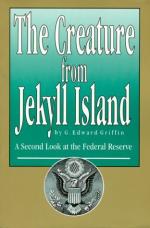
|
| Name: _________________________ | Period: ___________________ |
This test consists of 5 multiple choice questions, 5 short answer questions, and 10 short essay questions.
Multiple Choice Questions
1. What event sparked the conflicts that led to World War I?
(a) World War I started in 1914 with the intercession of the US into European affairs.
(b) World War I started in 1914 with a global economic collapse.
(c) World War I started in 1914 with the assassination of the Kaiser Wilhelm II of Germany.
(d) World War I started in 1914 with the assassination of the Archduke of Austria-Hungary, Francis Ferdinand.
2. What caused the boom-bust cycle in the U.S. economy following the Civil War?
(a) The boom-bust cycle was due to the establishment of the Federal Reserve.
(b) The boom-bust cycle was due to the widespread use of fiat money and the implementation of many economic tricks that were doomed to failure.
(c) The boom-bust cycle was due to the lack of oversight by the US Congress.
(d) The boom-bust cycle was due to the widespread use of paper currency not based by the gold standard.
3. What did the USSR implement instead of true Communism?
(a) The USSR never implemented true Communism but became a money-making machine for those trying to establish a quasi-capitalist system of government.
(b) The USSR never implemented true Communism but became a money-making machine for the secret money society that had turned into several branches called Round Tables.
(c) The USSR never implemented true Communism but became a money-making machine for the secret money society that was controlled by the United Nations.
(d) The USSR never implemented true Communism but became a money-making machine for the Axis powers.
4. How did some organizations profit during boom-bust cycles by buying bonds?
(a) Buying up bonds during booms gained tremendous value during bust times.
(b) Buying up bonds during busts gained tremendous value during the Great Depression.
(c) Buying up bonds during busts gained tremendous value ten years later.
(d) Buying up bonds during busts gained tremendous value during boom times.
5. What country was formed after the second Russian revolution?
(a) The country of Georgia was established after the second Russian revolution.
(b) Kurdistan was formed after the Russian revolution.
(c) New Poland was formed after the second Russian revolution.
(d) The USSR developed after the second Russian revolution.
Short Answer Questions
1. What is the Rothschild Formula?
2. What do some radical conspiracy theorists believe about the 9/11 attacks?
3. What debt would be incurred by future generations from currency devaluation?
4. What occurred after the economic downturn in 1818?
5. When was the first central bank founded in the US?
Short Essay Questions
1. What realistic scenario was discussed in Chapter 26 involving the U.S. monetary system?
2. According to Chapter 14, how many revolutions did Russia actually undergo?
3. According to Chapter 25, what did the author predict for the U.S. economy?
4. In Chapter 10, what resulted from the Mandrake Mechanism?
5. In Chapter 9, what restrictions were placed on the Bank of Amsterdam which was established in 1609?
6. According to Chapter 10, what is the basic structure of the US monetary system?
7. According to Chapter 21, what system was in control of the economy before the Federal Reserve System was established?
8. According to Chapter 24, what decade marked the beginning of a tremendous surge in U.S. debt?
9. In Chapter 16, when was the first central bank founded in the US?
10. In Chapter 12, what were the sales of English and French war bonds used for?
|
This section contains 1,006 words (approx. 4 pages at 300 words per page) |

|




